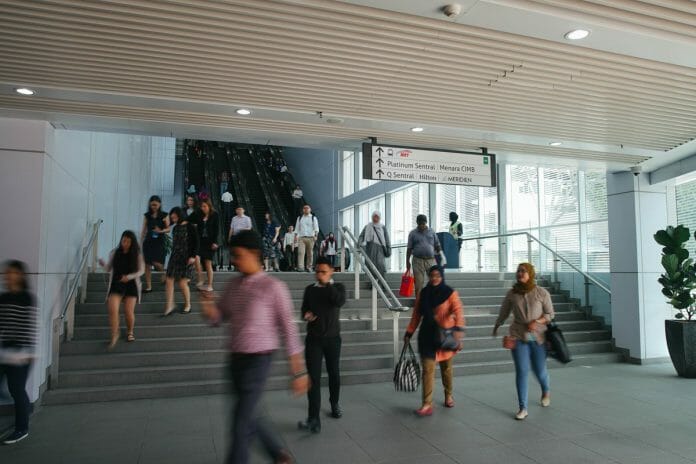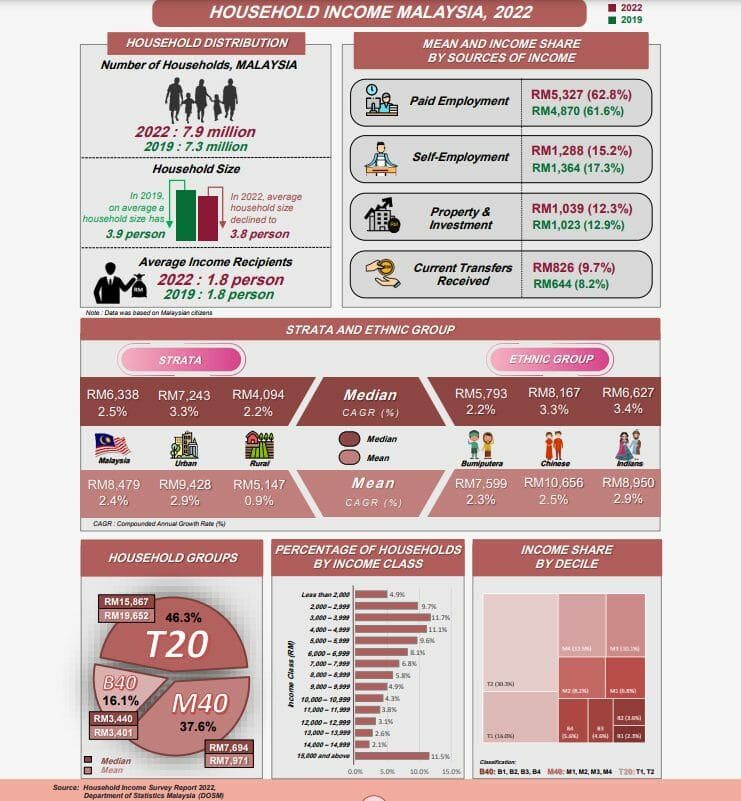DOSM recently released the Household Income Survey Report 2022 (Malaysia & States), which revealed a comprehensive suit of information pertaining to the subject.
Chief Statistician Malaysia Dato’ Sri Dr Mohd Uzir Mahidin said the median household income moderated by 2.5 per cent per year in 2022 to RM6,338. Likewise, the mean household income grew 2.4 per cent to RM8,479.
The income value takes into consideration the mean household size of 3.8 persons, with an average of 1.8 income earners. This household income comprises paid employment, self-employment, income from investment and current transfers received.
Uzir also explained that six states reached median income above the national level (2022: RM6,338), namely W.P. Kuala Lumpur (RM10,234), W.P. Putrajaya (RM10,056), Selangor (RM9,983), W.P. Labuan (RM6,904), Johor (RM6,879) and Penang (RM6,502).
Selangor recorded the highest median income growth of 6.5 per cent per year for the period 2019 and 2022. Meanwhile, W.P. Kuala Lumpur recorded a decline in monthly gross median household income of 1.0 per cent for the same period.
As for the monthly mean gross household income, four states, namely W.P. Putrajaya (RM13,473), W.P. Kuala Lumpur (RM13,325), Selangor (RM12,233) and Johor (RM8,517) recorded mean monthly household income that exceeded the national level of RM8,479 in 2022.
Selangor also recorded the highest annual growth rate with mean income of 4.1 per cent from RM10,827 to RM12,233, while W.P. Labuan recorded a decline in mean of monthly gross household income with a reduction of 0.3 per cent, from RM8,319 (2019) to RM8,250 (2022).
In addition, in line with the government’s proposal on disposable income as a basis for the approach in assisting the people, Uzir said, DOSM has taken the initiative by analysing the results of HIES 2022 from the perspective of disposable income.
Mean of monthly disposable household income increased by 1.7 per cent (RM7,111) as compared to 2019 (RM6,764). Meanwhile, the mean of monthly disposable household income also increased by 1.9% (RM5,413) from RM5,116 (2019).
Disposable household income represented 83.9 per cent of the total gross household income. From the angle of the income distribution pattern, the B40 income threshold, which includes 3.16 million households is RM5,249.
The M40 group recorded an income range between RM5,250 to RM11,819. Meanwhile, as many as 1.58 million households are in the T20 with income exceeding RM11,820.
The T20 group comprised 46.3 per cent of the total distribution of household income, down slightly from 46.8 percent in 2019. Meanwhile, the M40 group comprised 37.6 per cent, while the B40 only represented 16.1 per cent of total income, up slightly from 16.0 per cent in 2019.
This household group can also be detailed down to every one percent of households. Uzir further elaborated that the findings of 2022 showed that the value of the Gini Coefficient calculated based on gross income has recorded a decrease of 0.003 index points to 0.404 (2022) from 0.407 (2019).
This means that the income inequality gap narrowed by 0.3% in 2022 as compared to 2019. The Gini coefficient in urban areas decreased to 0.393 from 0.398 (2019), while the Gini coefficient in rural areas also decreased to 0.351 from 0.367.
The Gini coefficient by ethnicity also decreased for all ethnicities, with Bumiputera at 0.387 from 0.389, Chinese at 0.412 from 0.417 and Indians at 0.406 from 0.411. Despite the increase in household income in Malaysia, the income gap between ethnic groups is still significant.
The income gap between Chinese and Bumiputera ethnic groups is at a ratio of 1:0.71 (2022) as compared to 1:0.72 (2019). Meanwhile, the income gap between ethnic Chinese and ethnic Indians was 1:0.84 in 2022, which represents a marginal improvement as compared to 2019 (1:0.83).
From the angle of absolute poverty incidence analysis, Uzir stated that the value of the Poverty Line Income (PLI) in 2022 is RM2,589 (2019: RM2,208) with the PLI value of food amounting to RM1,198 (2019: RM1,169).
The absolute poverty incidence prior to the global health crisis was 5.6 percent in 2019. Based on the poverty estimation study conducted by DOSM on the effects of the COVID-19 pandemic, the incidence of poverty in 2020 increased to 8.4 percent and slightly decreased to 8.2 percent in 2021.
Next, the absolute poverty incidence in 2022 showed a decrease to 6.2 percent as compared to 2021. The 2022 absolute poverty incidence involves an estimated 487,576 households.
The urban poverty incidence also increased from 3.9 per cent in 2019 to 4.5 per cent in 2022, while in rural areas it recorded a decrease from 12.4 per cent to 12.0 per cent in the same period.
The number of extreme poor households with income below RM1,198 decreased to 0.2 per cent (18,445 households) as compared to 0.4 per cent (2019).
To provide a more comprehensive analysis of poverty, DOSM also releases relative poverty information that is determined based on 50 per cent of the median household income.
The relative poverty threshold in 2022 was RM3,169 with a relative poverty rate of 16.6 per cent. In addition, the Multidimensional poverty index (MPI) which complements the income-based poverty measurement, is also provided to identify aspects of people’s deprivation from the angles of educational facilities, health and standard of living.
Preliminary findings of poverty incidence multidimensional 2022 was 1.9 per cent compared to 2.6 per cent (2019) with the household variance was 40.9 per cent.
Thus, MPI decreased to 0.8 per cent compared to 1.1 per cent (2019). A report on MPI’s findings will be published in August 2022. Commenting on the HES report, he said that, on average, households in Malaysia spent RM5,150 per month in 2022, which is an increase of 3.7 per cent per year for the period from 2019 to 2022.
In addition to the income received by households, part of this expenditure is financed by non-income receipts such as government assistance and special withdrawals of savings through the Employees’ Provident Fund (EPF).
Apart from that, based on the allocation of expenses made by households, the composition of the expenditure pattern (66.9%) still focuses on four main expenditure groups, namely Housing, water, electricity, gas & other fuels (23.2%); Food and non-alcoholic beverages (16.3%); Restaurant and hotel (16.1%); and Transportation (11.3%). Spending on the Restaurant and hotel increased by 2.4 points to 16.1 per cent (2019: 13.7%).
This situation is in line with the increase in spending on eating out to 15.3 per cent (2019: 11.2%) and the decrease in eating at home to 16.3 per cent (2019: 16.9%).
As a result of the COVID-19 pandemic, the composition of expenditure on Health also increased by 0.6 percentage points in 2022 with part of it was expenditure on health goods such as face masks, disinfectant liquid and COVID-19 screening test kits.










